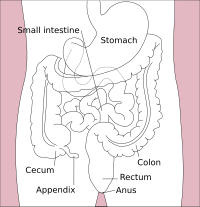
Photo from wikipedia
Tissue homeostasis in the female genital tract is challenged by infection, damage, and even physiological events during reproductive cycles. We propose that the evolutionarily ancient system of innate immunity is… Click to show full abstract
Tissue homeostasis in the female genital tract is challenged by infection, damage, and even physiological events during reproductive cycles. We propose that the evolutionarily ancient system of innate immunity is sufficient to sense and respond to danger in the non-pregnant female genital tract. Innate immunity produces a rapidly inducible, non-specific response when cells sense danger. Here we provide a primer on innate immunity and discuss what is known about how danger signals are sensed in the endometrium and ovary, the impact of inflammatory responses on reproduction, and how endocrinology and innate immunity are integrated. Endometrial epithelial and stromal cells, and ovarian granulosa cells express pattern recognition receptors, similar to cells of the innate immune system. These pattern recognition receptors, such as the Toll-like receptors, bind pathogen-associated or damage-associated molecular patterns. Activation of pattern recognition receptors leads to inflammation, recruitment of immune cells from the peripheral circulation, and phagocytosis. Although the inflammatory response helps maintain or restore endometrial health, there may also be negative consequences for fertility, including perturbation of oocyte competence. The intensity of the inflammatory response reflects the balance between the level of danger and the systems that regulate innate immunity, including the endocrine environment. Understanding innate immunity is important because disease and inappropriate inflammatory responses in the endometrium or ovary cause infertility.
Journal Title: Journal of reproductive immunology
Year Published: 2017
Link to full text (if available)
Share on Social Media: Sign Up to like & get
recommendations!